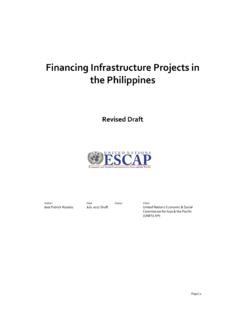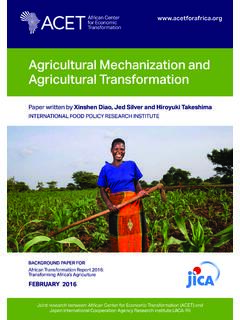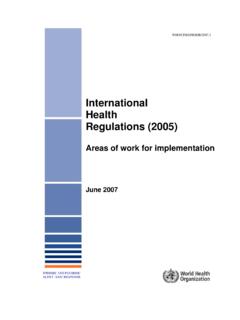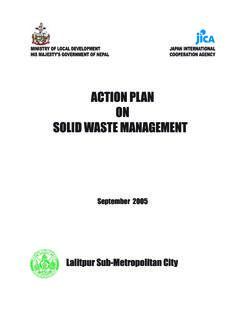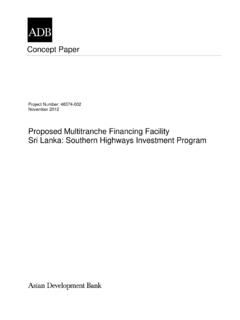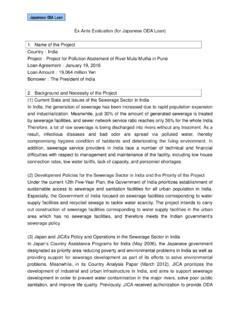Transcription of Miguel Paolo P. Reyes University Research Associate Third ...
1 It's Not You, It's Me? An Inquiry into the Problems of Philippine-Korean cooperation for Metro Manila's Rail-based Mass Transit Systems Miguel Paolo P. Reyes University Research Associate Third World Studies Center College of Social Sciences and Philosophy University of the Philippines Diliman Email address: Abstract japan , Belgium, and the Czech Republic are the countries typically associated with rail-based mass transit systems in Metro Manila. Recently, South Korea has joined their ranks. However, at least in the Philippines, South Korean involvement in Metro Manila's Light Rail Transit (LRT) and Metro Rail Transit (MRT) systems has received bad press. Hyundai Adtranz provided the first air-conditioned rolling stock for LRT line 1 in 1999; of the twenty-eight cars that were delivered, only eight remain in service. Manila-based Busan Universal Rail, Inc.
2 , which, until recently, held the maintenance contract for the MRT with the Busan Transportation Corporation of Korea, was often blamed for the MRT's frequent breakdowns of late. South Korea's involvement in the rehabilitation of the Philippine National Railways (PNR), particularly the Metro Manila South Commuter Line, has seemingly yielded little fruit;. even after purchasing Korean rolling stock (diesel multiple units) as well as granting loans for rehabilitation purposes via the Korean Exim Bank, the PNR remains moribund. This paper asks, "Why have Korean companies seemingly failed to transfer their knowledge or experience of providing for or operating and maintaining some of the world's best urban rail-based mass transit systems to Manila?" An answer thereto is attempted via constructing a historical narrative based on primary sources ( , published first-hand accounts, data from the Light Rail Transit Authority and PNR).
3 And secondary sources ( , opinion pieces in newspapers). National leadership transitions and geopolitical dynamics as well as the activities of certain "dealmakers" within the Philippines emerge as some of the explanations for Korea's "failed" Manila mass transit ventures. Introduction On 6 November 2017, the Metro Rail Transit Line 3 (MRT3) maintenance contract between Busan Universal Railways, Inc. (BURI) and the Department of Transportation (DOTr)i was terminated, less than two years after the latter contracted the services of the former (specifically, on 7 January 2016) (Cabuenas, 2016, 2017). Reports stated that these were the reasons for terminating the contract: Poor performance ( that constitutes derailments, passenger unloading, stoppages );. Failure to put in service and subsequently ensure the availability of the contractually obligated number of trains, and failure to put in operation reliable and efficient trains.
4 Failure to implement a feasible procurement plan for spare parts ; and Failure to comply with the contractual requirements of a complete and up- to-date Computerized Maintenance Management System (Cabuenas, 2017; Ramirez, 2017). Exactly the same reasons were given by DOTr when it gave the notice of termination of contract to BURI on 20 October 2017 (Bacungan, 2017). It was an inauspicious conclusion to a relationship that started with promise new coaches from China, manufactured by Dalian Locomotive, were set to arrive, and the Korean participant within BURI the Busan Transportation Corporation (Busan) had years of experience in managing a multi-line mass transit system (Cabuenas, 2016). But the MRT3 continued to decline in terms of quality of service it is widely considered to be the least reliable among Manila's three segregated mass transit railway lines, given how frequently it breaks down well into the first months of the Rodrigo Duterte administration.
5 This paper deals with such Filipino-Korean collaboration in Metro Manila's four mass transit railway lines the MRT3, the Light Rail Transit (LRT) Line 1, LRT 2, and the Metro Manila (South) Commuter Service of the Philippine National Railways (PNR). As will be detailed here, like the BURI-DOTr deal, many of the major involvements of Koreans in Manila's railways can be considered failures, the common reasons for which are the failure of Korean companies to secure contracts, especially when they are in competition with the Japanese government-business complex also called japan , Inc. (Lee & Yoo, 1987: 73) which is financed through the Overseas Economic cooperation Fund/ japan Bank for international cooperation ,ii and, when they do win contracts, are met with mainly governance-related roadblocks/bottlenecks to fulfilling their obligations.
6 The approach of this paper is primarily historical, focusing on the factual narratives . here, what can also be construed as five case studies than can be drawn from various primary and secondary sources. Among these are materials gathered from PNR, such as financial statements, briefers/chronologies, loan summaries, and a document giving lengthy technical specifications of the Korean diesel multiple units (DMUs) currently in PNR's fleet; documents detailing assets of the Light Rail Transit Authority (LRTA) from the Commission on Audit (COA); studies/documents housed at the library of the University of the Philippines National Center for Transportation Studies; studies and evaluations made by the japan international cooperation agency ( jica ) in cooperation with private Japanese firms; various documents including contracts from DOTr; and documents from the LRTA.
7 These are all supplemented by interviews, mainly with people (formerly) employed by or affiliated with PNRiii and a BURI executive. Dozens of news articles (from over 4,000 gathered) were also deemed relevant for this study. Lastly, a number of existing studies on or related to the history of rail-based mass transit in Manila were consulted. All of these sources were gathered through a Research program headed by Ricardo T. Jose entitled The Mass Transit System in Metro Manila: From Tranvia to MRT, 1979-2014, funded by an Emerging Interdisciplinary Research (EIDR) Grant from the UP Office of the Vice President for Academic Affairs. The discussion here will largely progress chronologically, focusing on developments from the latter years of the Marcos regime to BURI's involvement in the MRT3, spanning over three decades. Patterns of involvement emerge in the proceeding discussion: we shall examine cases of unsolicited proposals, private consortium participation, and public-private consortium participation.
8 The type of involvement is tied to the type of bidding and financing for a project, , unsolicited proposals using (proposed) foreign/aid- agency financing, public bidding using foreign/aid- agency financing, public bidding using state funds, negotiated procurement after failed bidding using state funds. Korean involvement was found to be most successful, in terms of consistency of quality of contribution and generation of controversy, in a private consortium participation-public bidding using foreign/aid- agency financing model, wherein the private consortium is stable ( , Hyundai Rotem and LRT 2); if the consortium is unstable ( , vulnerable to shocks, has undercapitalized constituents), there is a fair chance that the venture will fail ( , Hyundai Adtranz and LRT 1 [private consortium with public bidding using foreign/aid- agency financing] and Korail and LRT 1 [private consortium with public bidding using state funds).]
9 Moreover, that model involves relatively minor participation (limited, say, to the provision of rolling stock) in comparison to others. The other models shown here are unsolicited proposals by private consortia with proposed foreign/aid- agency financing (Yook Sung Mool San Co. the Hanbo Corporation, and PNR [proposal only]). and public-private consortium with public bidding using foreign/aid- agency financing (Rotem and PNR). Background: Mass Transit Railways in South Korea and the Philippines Both Seoul and Manila have firsts in terms of rail-based mass transit: Seoul was the first in non-communist Asiaiv after japan to have a postwar urban mass transit railway system the Seoul subway line 1, which started construction in 1971 and was inaugurated in August 1974 while Manila was the first in Southeast Asia to have a postwar light rail transit system LRT 1 which started to rise in 1981 and was carrying paying passengers by December 1984.
10 The PNR intra-Manila commuter service did start in 1972, but it utilized the same track as the province-bound PNR. trains and had only a small ridership share. The possibility of constructing a subway for Seoul was raised as early as 1953 (Deswysen, 1953); in 1961, we first encounter plans to construct a rail-based mass transit system, in the form of an unrealized proposal to build a monorail system, for the City of Manila (Manila Times, 1961). Korea was, in other words, always ahead by about a decade in terms of both planning and construction. The Korean system was also more forward-thinking in terms of connectivity. Seoul's subway was designed to connect the Seoul Central Railroad Station with the city's eastern outskirts (AP, 1974), while the World Bank-funded transportation plan that pushed for the construction of a (street-level) LRT in Manila, the Metro Manila Transport, Land Use and Development Planning Project, or MMETROPLAN, did not highlight the necessity of linking an intra-urban light rail system with the PNR (there is still no LRT-PNR interchange to this day).
